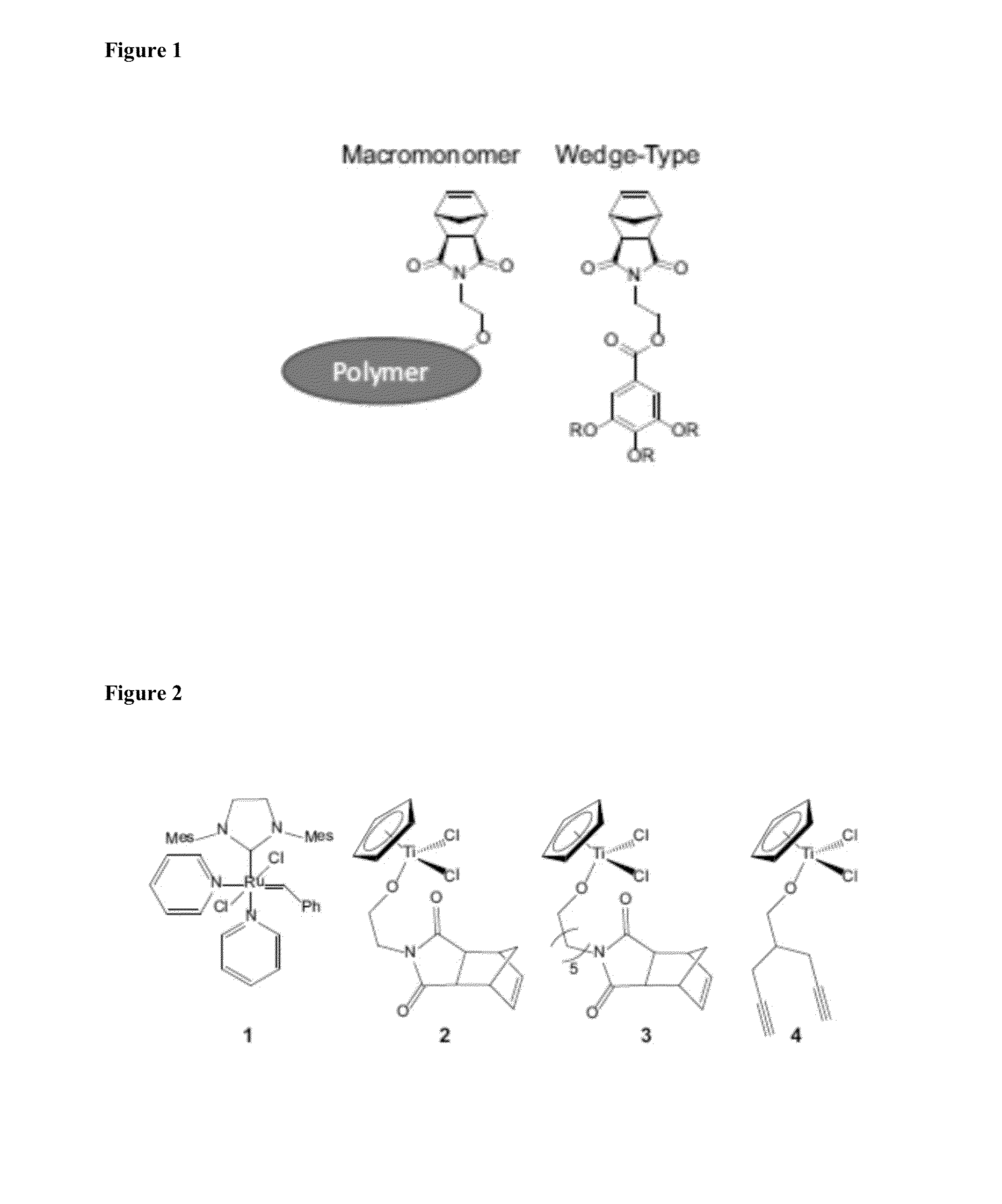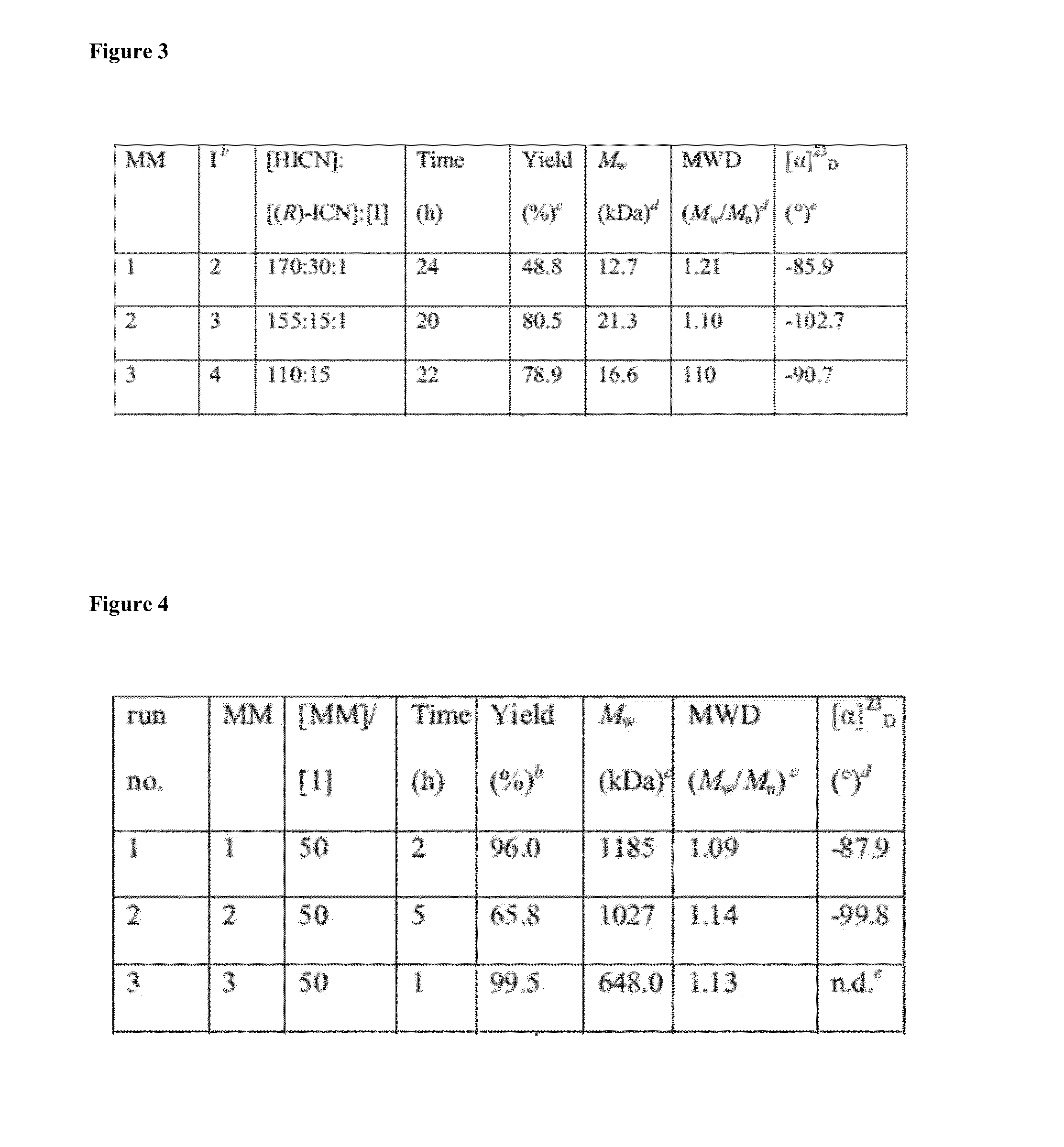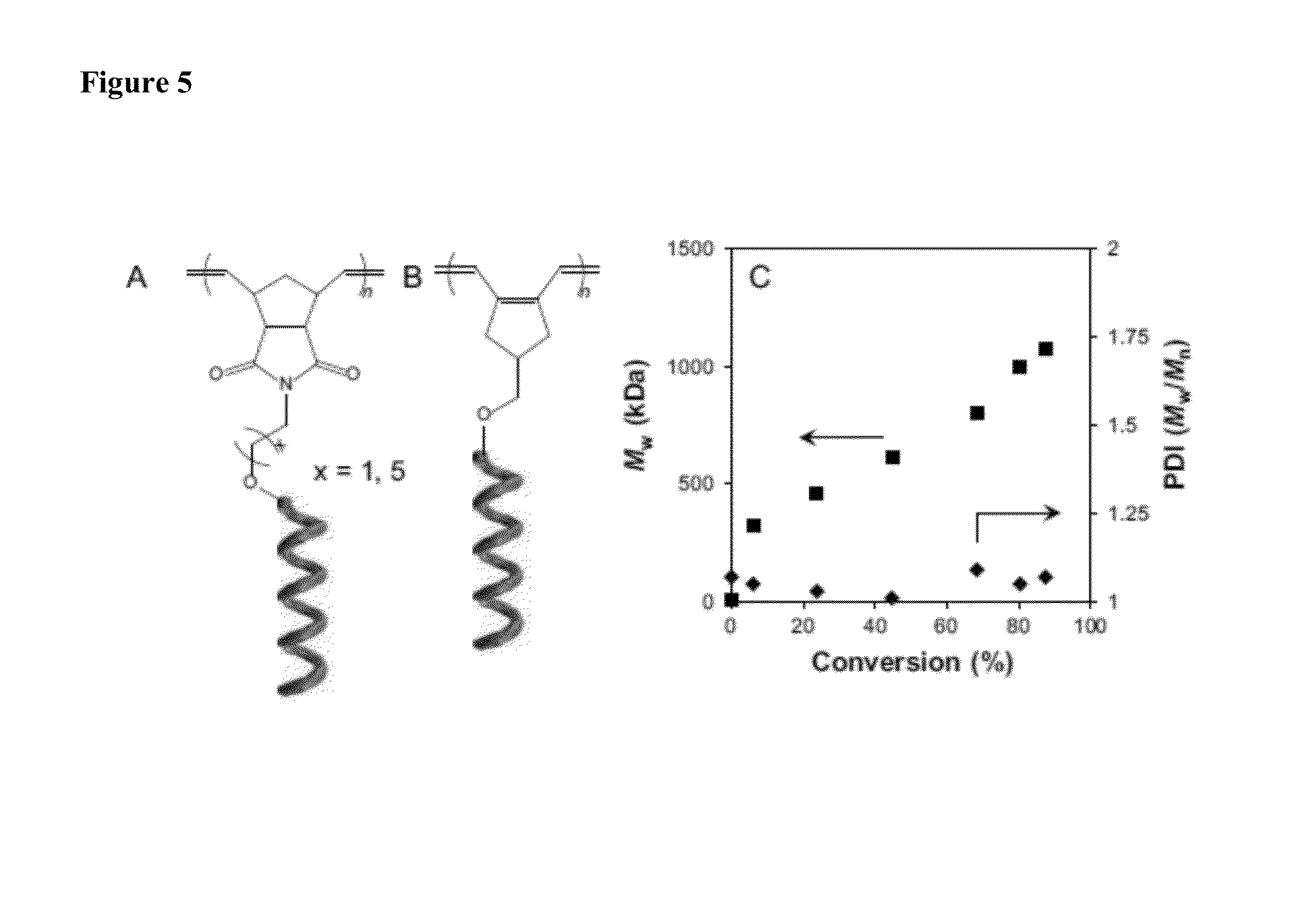Chiral Polymers for the Self-Assembly of Photonic Crystals
a technology of photonic crystals and chiral polymers, which is applied in the field of chiral polymers for the self-assembly of photonic crystals, can solve the problems of limited the ability to generate unique bandstructures for different wavelengths, and the construction interference of reflected ligh
- Summary
- Abstract
- Description
- Claims
- Application Information
AI Technical Summary
Benefits of technology
Problems solved by technology
Method used
Image
Examples
example 1
General Materials and Methods
[0128](H2IMes)(PPh3)2(Cl)2RuCHPh was received from Materia Inc. and converted to 1 via literature procedure. All other chemicals were purchased from Sigma Aldrich. (R)-2,6-dimethylheptyl isocyanate, 4-(hydroxymethyl)-1,6-heptadiyne, N-(hydroxyethyl)-cis-5-norbornene-exo-2,3-dicarboximide, N-(hydroxyhexyl)-cis-5-norbornene-exo-2,3-dicarboximide, and CpTiCl2(C11H12NO3) (2) were made according to literature procedures. Solvents were purified by passage through solvent purification columns and further degassed with argon. Hexyl isocyanate and (R)-2,6-dimethylheptyl isocyanate were dried over CaH2 overnight and vacuum distilled.
[0129]All reactions were carried out in flamed Schlenk-type glassware on a dual-manifold Schlenk line or in a nitrogen-filled glovebox. NMR spectra were recorded on a Varian Inova 300 MHz spectrometer. Chemical shifts were referenced to internal solvent resonances and are reported as parts per million relative to tetramethylsilane. Hig...
example 2
Synthesis of Metal Complexes
Synthesis of TiCl2O3NC21H25 (3)
[0130]In a 100 mL flask, CpTiCl3 (1.08 g, 4.92 mmol) was dissolved in 20 mL of benzene. With vigorous stirring, a solution of N-(hydroxyhexyl)-cis-5-norbornene-exo-2,3-dicarboximide (1.29 g, 4.92 mmol) and triethylamine (0.498 g, 4.92 mmol) in 20 mL benzene was added dropwise to the titanium solution. The mixture was allowed to stir for 2 hours before being filtered. The volatiles were removed and the solid was recrystallized from a toluene / pentane solution mixture to afford the product (0.856 g, 38.9%) as a yellow powder.
[0131]1H NMR (C6D6, 300 MHz, 25° C.): δ 6.06 (s, 5H), 5.68-5.67 (m, 2H), 3.98 (t, 6.09 Hz, 2H), 3.39 (t, 7.35 Hz, 2H), 2.98-2.92 (m, 2H), 2.14-2.08 (m, 2H), 1.47 (q, 7.35 Hz, 2H), 1.29-0.99 (m, 8H). 13C NMR (C6D6, 75 MHz, 25° C.): δ 178, 138, 119, 85.1, 48.2, 45.7, 43.1, 38.8, 33.1, 28.2, 26.9, 25.5. HRMS (FAB+): Calculated: 446.0769. Found: 446.0766.
Synthesis of TiCl2OC13H14 (4)
[0132]In a 50 mL flask, CpTi...
example 3
Synthesis of Marcromonomers
Synthesis of MM-1
[0134]A 10 mL flask was charged with 16.5 mg (42.3 μmol) of 2, 100 μL THF, and a stir bar. With vigorous stirring hexyl isocyanate (0.917 g, 7.21 mmol) and (R)-2,6-dimethylheptyl isocyanate (0.250 g, 1.36 mmol) were added simultaneously. After 24 hours the reaction had solidified. The solid was stirred in methanol and filtered, redissolved in methylene chloride, and reprecipitated into methanol. The macromonomer was isolated by filtration and dried to a constant mass via vacuum to afford a white solid (0.596 g, 48.8%).
[0135]1H NMR (CDCl3, 300 MHz, 25° C.): δ 6.31 (bs), 4.30 (bs), 3-98-3.35 (m), 3.29 (bs), 2.72 (bs), 2.11 (bs) 1.59 (bs), 1.29 (bs), 0.87 (bs).
Synthesis of MM-2
[0136]A 10 mL flask was charged with 55.3 mg (123 μmol) of 3, 100 μL THF, and a stir bar. With vigorous stirring hexyl isocyanate (2.44 g, 19.2 mmol) and (R)-2,6-dimethylheptyl isocyanate (0.350 g, 1.90 mmol) were added simultaneously. After 20 hours the reaction had so...
PUM
| Property | Measurement | Unit |
|---|---|---|
| Wavelength | aaaaa | aaaaa |
| Chirality | aaaaa | aaaaa |
| Optical properties | aaaaa | aaaaa |
Abstract
Description
Claims
Application Information
 Login to View More
Login to View More - R&D
- Intellectual Property
- Life Sciences
- Materials
- Tech Scout
- Unparalleled Data Quality
- Higher Quality Content
- 60% Fewer Hallucinations
Browse by: Latest US Patents, China's latest patents, Technical Efficacy Thesaurus, Application Domain, Technology Topic, Popular Technical Reports.
© 2025 PatSnap. All rights reserved.Legal|Privacy policy|Modern Slavery Act Transparency Statement|Sitemap|About US| Contact US: help@patsnap.com



